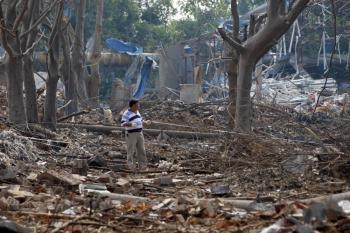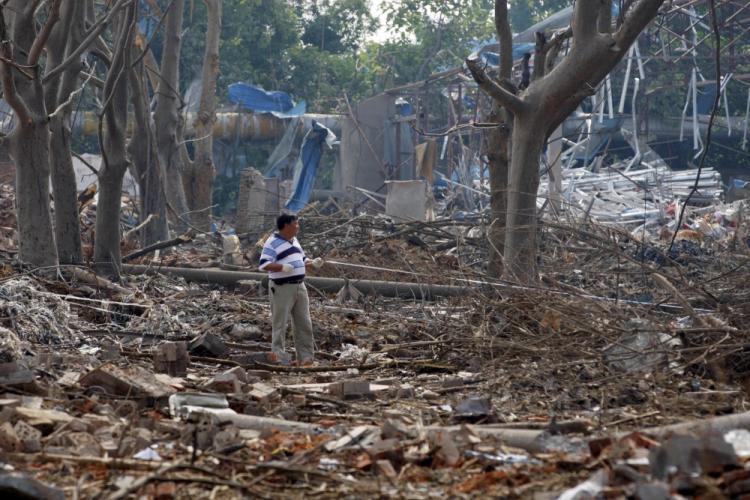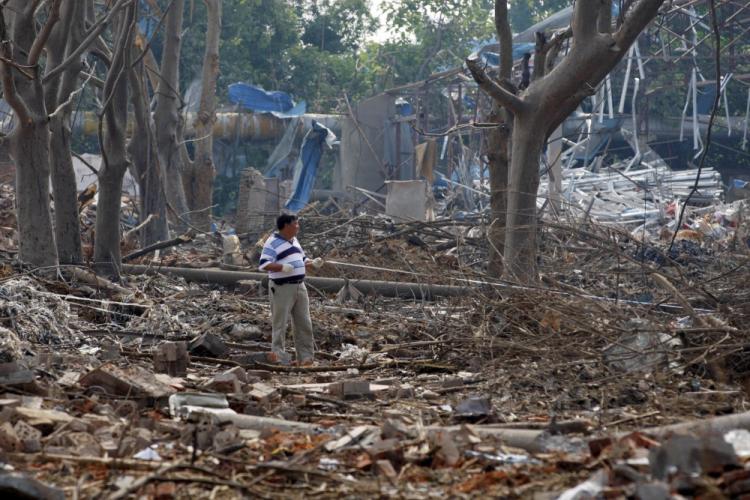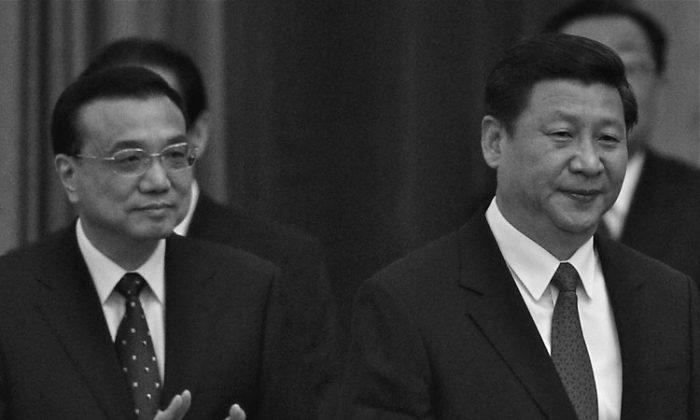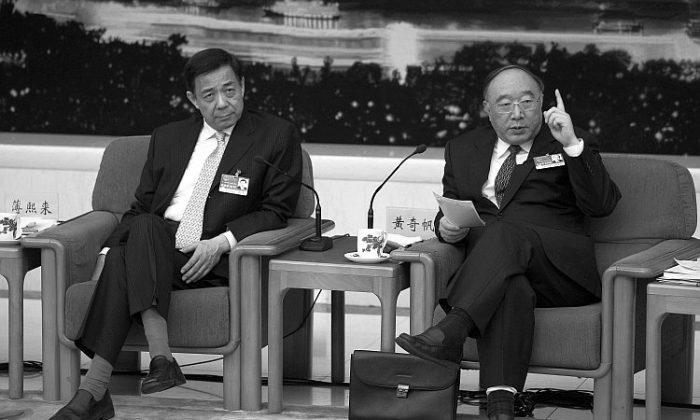After an explosion in Nanjing, China, last week, conflicting reports emerged about the location, cause, and number of casualties. Available evidence suggests that Communist Party officials both directly and indirectly tampered with the reporting process, while Western media adopted the line taken by Chinese state media in their reports of the incident.
The press conference also confirmed that a massive fire had broken out, killing 13 people and injuring 120, 14 of who were in critical condition; 4,300 households were said to be damaged.
Questions from the public quickly arose, registered in conversations and on blogs, such as why live TV coverage was banned at the site; why the location of the explosion was said to be a plastics plant by some, an liquid petroleum gas (LPG) factory by others, and a chemical plant by yet others; and why there was an air of secrecy surrounding the number killed. Confusion and speculation was fueled by the fact that the explosion took place in a densely populated neighborhood.
‘More Than 100 Bodies’
Soufun.com first reported that the explosion occurred at an LPG factory in Maigaoqiao, a suburb in the Qixia district of Nanjing, on the afternoon of July 28, and that 79 people were killed. After that, several other Chinese media published similar reports.
The first eyewitness to report the incident was Chen Guangbiao, an entrepreneur and noted philanthropist. He told Wenzhou Net on the afternoon of July 28 that “There were two bigger explosions. After the biggest one, people nearby all had tinnitus for a short while.”
He also told Shanghai TV: “I’m not exactly sure how many people were killed, but more than 100 bodies were carried out.”
Chen’s account differed from the official report, which claimed that only 13 were killed, and gave no mention of the explosion occurring in an old LPG factory. State media had reported that a propylene pipe was damaged during the demolition of a plastic plant, and that the leaking propylene was ignited by a privately-owned car started nearby, at 10:15 a.m.
Western media reported the story in the same manner, often without attributing the claimed death toll to Chinese state sources.
A doctor disclosed that the mayor had insisted that the injured could not be reported dead until three days after being hospitalized: by then the deaths would be counted as a result of the wounds rather than the accident. According to a report by Apple Daily, a broadcast reporter said the department concerned had given under-the-table money to Chinese media in an effort to have them keep the number killed under 10.
Several Nanjing residents told The Epoch Times that at least 100 people had been burned to death by the LPG explosion . A man identifying himself as an eyewitness said that he thought that up to 170 people may have died.
Local Media Reticent
While the disaster was making headlines elsewhere, Nanjing media was largely quiet about the incident, except for Modern Express, which ran the news on the front page. Modern Express is run by the Xinhua News Agency’s Jiangsu branch; Xinhua is the official mouthpiece of the Communist Party.
Staff from one of Nanjing’s most popular newspapers, Yangtse Evening Post, posted a message on its official micro-blog that was later removed: “Today, we received a lot of criticism, which was much anticipated. In fact, we originally had prepared nine pages of coverage but it turned out to be what you are seeing now. We are sad, frustrated and in pain!”
Soon after the explosion, live television coverage by a Jiangsu station was stopped by a propaganda official, a piece of footage that was copied among Chinese blogs and decried by netizens.
Relief Efforts to the Fore
The way the explosion news was handled generally is indicative of new trends in how Communist Party propagandists are adapting to an information rich environment, according to Choi Yung Mei, Executive Editor of the Hong Kong-based Open Magazine.
“The news coverage is very strange, in that its reporting emphasizes disaster relief rather than the disaster itself,” she said in an interview with Voice of America. Rather than simply blocking all news of the report, officials attempt to turn “mishaps or disasters into publicity opportunities. As to what the disasters were--which is supposed to be the core of the news--they are hardly mentioned.”
The result is a pastiche of footage showing diligent rescue workers searching for survivors at the explosion site, medical workers treating victims at the hospitals, and concerned citizens rushing to donate blood after hearing news of blood shortages.
Other ‘concealed bombs’
According to China Youth Daily, several communities near the blast site were put under martial law after the explosion. The ground was covered with broken shards of glass. As one resident described it, “No household was in one piece.” She was there to bring food to her mother, because “natural gas [for cooking] was cut off. Communications were down too. There are 19 buildings, with altogether over 1000 households in this neighborhood.”
The explosion turned to rubble buildings within 200 meters (about 650 feet), and shattered windows within a two kilometer (1.25 mile) radius. The windows and doors of buses nearby were shattered, passengers escaping in panic.
The Maigaoqiao area has chemical plants, gas stations, and LPG filling stations, along with obsolete chemical plants, all with underground pipelines, and all within what are now residential neighborhoods. Before the recent explosion, on May 27 the Nanjing Morning Post carried a report that a propylene pipe in the Qixia district of Nanjing was broken during digging, causing a leakage that forced 1000 people to evacuate the area.
Residents report having called for a halt to the building of gas stations, and for chemical plants to be moved out of the neighborhood; authorities are said not to have paid heed.
